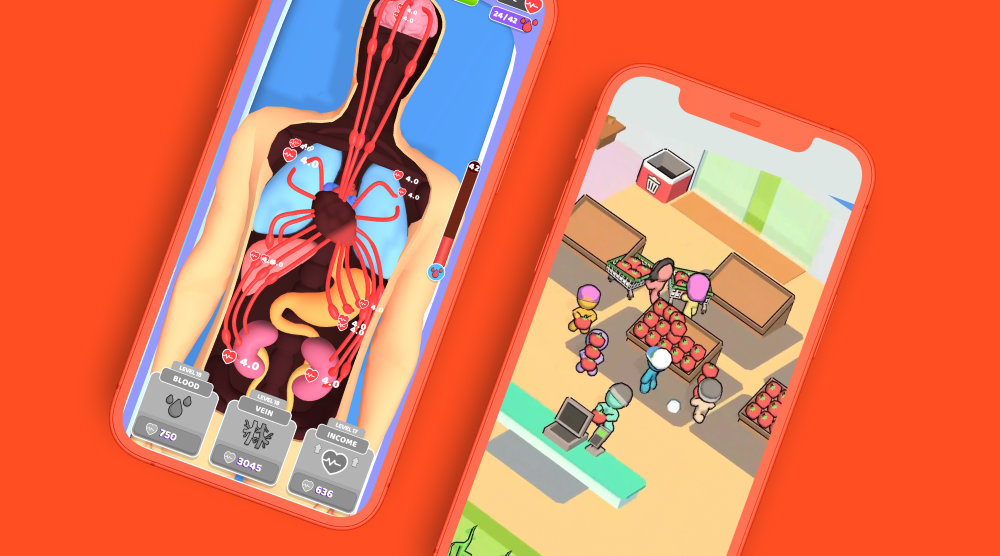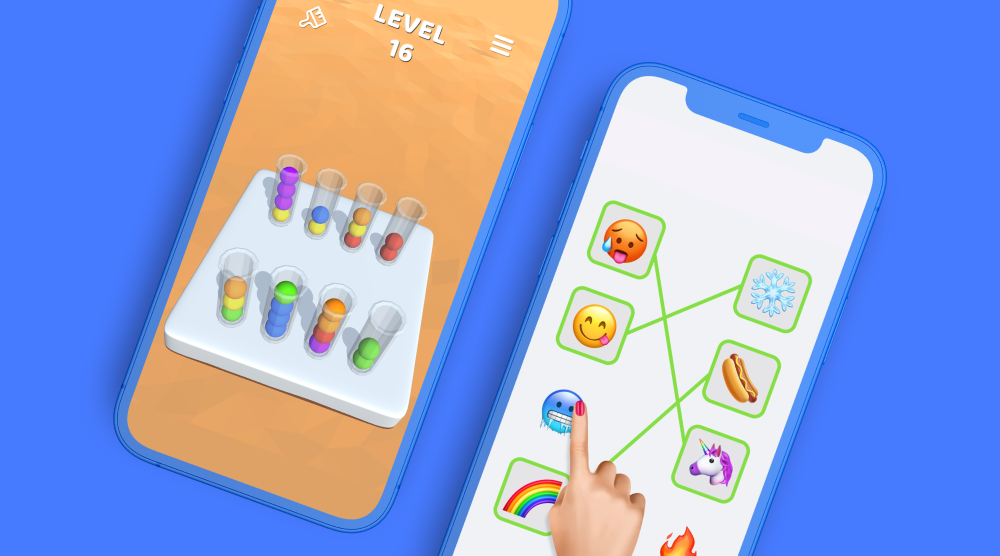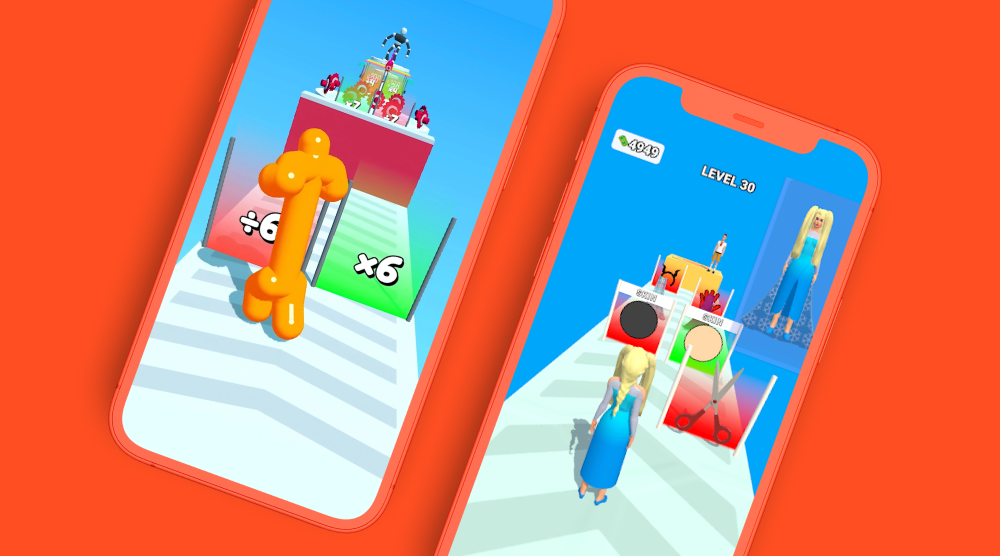In a marketability test, your goal is to test the product-market fit of your game and aim for a low CPI and high CTR or IPM. To do that requires an engaging video that hooks the user and is true to your game. The good news is that there are tangible tips for designing effective creatives to help you hit your marketability test KPIs and move on to the next stage of the 3-pronged holy triangle of growth: retention, and monetization.
We spoke with Alex Leshkov, Motion Designer Lead at Supersonic, about his experience launching hit games by designing and optimizing creatives. Here were his tips for developers looking to do the same and pass the marketability testing stage with the lowest CPI possible, and examples of how the creatives team at Supersonic put these tips in action.
1. Play the game
Pinpointing the most engaging parts of your game is the foundation of designing good marketability creatives. To identify the most appealing levels, play through the game yourself and ask people outside of the core development team to play, too. Maybe the team loves playing with the character on level 3, or they get frustrated - that’s a good thing - on level 12. These are the levels you can test as creatives for marketability testing. After laying the foundation of your creative strategy, it’s time to move onto testing different variations.
2. Try out 4 different variations
We suggest creating 4 versions of your creative to test in the marketability stage. A good number will enable you to try out new ideas without having an overwhelming amount of variations so you can accurately see which parts of the creative are working.
Some design elements to test in your 4 variations include:
- Frame composition and camera angle
- A tutorial-like feature to make it easy to understand how to play (e.g. a hand pointing at a button)
- The right color palette for your game, which is a psychological tip - blue, for example, is proven to be the most appealing color to users
- Character design and how you illustrate them (e.g. cleaner, simpler, and less realistic)
3. Focus on the first 3 seconds
The first 3-5 seconds of a marketability creative are the most important - not only do you need to grab users’ attention but you also need to explain what the game is all about.
The point of a marketability test is to check that your game is a product-market fit, so if users don’t get what the game is, you can’t properly test if they’ll like it or not. As you work on your 4 different creative variations, focus on making them clear and easy to understand in the beginning. This is especially important for hyper-casual games - because the LTV is low, you need creatives that will draw in as many users as possible and keeping things simple will attract a wide range of demographics.
There’s also a lot of competition from other games - as users are scrolling through their social media feeds, the aim is to stop them in their tracks so they watch the full video. You can show a pointer, like a hand with red nail polish that shows users what to do, or provide text, like “Hit” to show where users would tap the screen, which describe or show users how to play within that 3-5 second time frame. Using music and sound effects can also get a user’s attention in a social media feed and encourage them to watch your entire creative.
4. The fail situation could be a winner
70-80% of the most successful creatives we’ve launched show a “fail situation”, which is when the player in the video loses the level. Not only does this challenge the user to do better, but it also fairly represents gameplay. In at least one of your creative variations, show failed gameplay in the first 3-4 seconds and end the video on the message or image that appears when users fail a level.
Bazooka Boy’s best-performing creative was a video showing a level fail again and again. During their marketability test, the game had a CPI of just $0.15 and later went on to achieve an LTV of over $1.
5. Take a risk
Be sure to make one of the four creative versions quirky or unusual. Think outside the box on this one - the creative should still connect to your theme and gameplay, but it should be more unique than the rest of the creative set. Sometimes it takes the wild card to crack the marketability test.
When designing the creatives for Chat Master, for example, we tried a version using a voice-over. We used audio for Air Control, too, putting realistic sound effects over the video creative. In this video, we showed a person in real life drawing the game’s concept, which was an unexpected and meta way to design game creatives.
6. Analyze the CPI
Your game’s CPI is a learning tool to help you improve for your next game or marketability test. Look at the games that had the lowest CPIs on your previous marketability tests and apply those learnings to your current game. If 3 of your previous top-performers all included text on-screen and used a static camera angle, try that out in your creatives. Look on SensorTower, too, for similar, successful games (those with a low CPI) and see how they designed their creatives to help inspire your own.
7. Adapt the creative to Facebook
Creatives for marketability testing will usually get launched across social media and media ad networks - and Facebook is usually top among these. Designing your creatives so they fit with Facebook’s UI maintains a seamless user experience and looks native to the platform so users don’t feel like they’re being shown an ad. Changing the frame to white in your creatives is a simple but effective way to blend in with Facebook’s feed and encourage people to engage.
You can also use a thumbnail image which gives users an accurate idea of what your game is about and draws them in before they even click into the creative. Without a thumbnail image, the creative will automatically start playing as users scroll through their feeds - and they could scroll right past yours. Using a thumbnail, though, encourages users to engage and watch your creative all the way through because they’re opting in to play it.
To hook users with a thumbnail, we suggest showing strong emotion, using a bright background, and using clear text or imagery that portrays what the content of the video will be. When best practices like this are applied, we’ve found that thumbnails can help lower CPI 7-10%, which is a big advantage for hitting the KPIs of your marketability test.
These tips in action
We’ve just gone over 6 tips for improving your hyper-casual creatives, but sometimes seeing is believing. Let’s look at two examples of creatives that decreased CPI using a mix of the tips above.
For Stacky Dash, we started with a version that featured a pale green environment and had a CPI of $0.41. We tested a few iterations like we suggest in tip #2, and analyzed the CPI (tip #6) before deciding to focus on changing the color and saturation of the background. We kept the same situation (a level fail, like tip #4) but changed the color to a bright pink so it stood out on social (tip #7) and engaged more users, which led to a significant decrease in CPI - to $0.28.
Chat Master is another example where we applied a few of the tips above to optimize the creative and reduce CPI. The first version on the left - which had a CPI of $0.40 - featured a stylized chat format and a pointer on screen. We then thought outside the box and tried something unusual, like in tip #5, by adding an image of a real girl playing the game and speaking as she types. We also finished the creative on a fail message (tip #4) and changed the format (tip #2) so it looked like an iOS chat. The resulting version with our optimizations lowered CPI to $0.30.
Go forth and test!
Passing the marketability test usually comes down to testing, testing, testing - testing different variations and trying out new ways to feature your game. Even if you fail the first, second, and third time, keep applying what you’ve learned to the next test or game to continue reducing CPI. Each marketability test is a learning opportunity about what’s working in your game and what you should try next in your creatives along the journey to launching a hit game.
Let's put these tips to good use
Publish your game with Supersonic



